Super Monkey Ball 2
There isn't a ball around big enough to hold Tom, so for him, this is a true fantasy
This is a very rough calculation, but we'd say it took 15 hours before we broke our first pad on Super Monkey Ball. It was as we munched the 'Advanced' banana for the fifteen-bagillionth time, dashing our chances of continuing by going for a distant ribbon up a narrow gangway, ironically in the hope of catapulting ourselves further into the game. Conscious (to some degree) of the short length of the controller cord and the potential of the GameCube to go flying off the shelf, we beat the smirking crap out of a stuffed Pikachu for a whole minute. We survived. Pikachu survived. The pad did not.
In this household, there is one measure above all else that determines the true quality of a game, and it is, quite simply, how long does it take us to go back to a game after we've destroyed the first peripheral?
In SMB's case, we were actually playing it with pad two whilst we destroyed pad one. Back for 2003, this Super Monkey in a Ball hopes to claim the scalp of my prized WaveBird, with 100 new levels, six refurbished, returning party games and six brand new efforts to cut our chequebooks on. With so much to do, we had to keep an economically viable victim within reach! Er, Rupert? Where did you go?
Except, after a while it became clear that you won't need to kill your boss or shower the floor in shards of plastic, because Sega has overreacted to complaints that the first game was too hard by redressing the balance with an anvil, ACME-style.
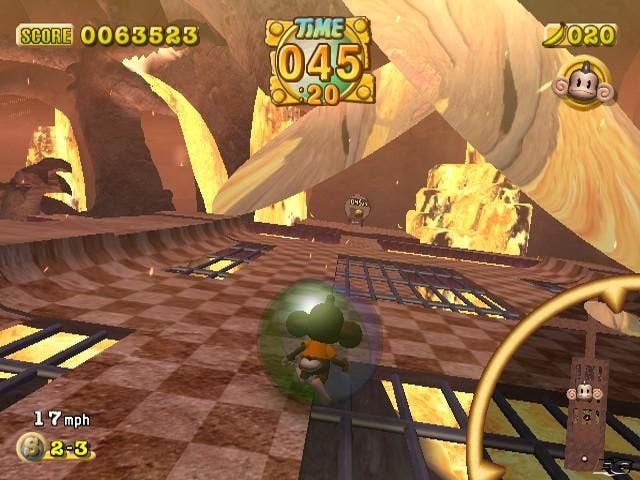
Marble Monkeys
On a fundamental level, SMB2 is still the same game. You still have to toil your way across 100 cleverly constructed, chequer-boarded levels, earning Play Points as you go, 2500 of which are needed to unlock the new party games (and everything's a party game now, with no feeble mini/party distinction). As a goodwill gesture, the returning half of the first game's 12 party titles are available from the start, emblazoned with a '2' and variously altered. And as before, anything you can do on your own is far more entertaining in a group.
The biggest change the game makes affects the maze mode, which is now split into Story and Challenge. Each mode sends you through the game's 100 levels by various routes; Challenge acts like the main mode from the original game, with 10-level Beginner, 30-level Intermediate and 50-level Advanced courses with a finite number of continues, whilst Story mode splits the game into manageable chunks of 10 levels each, lets you tackle the current ten in any order you like and offers infinite retries.
Story mode also throws up some wacky cut sequences, which see Aiai, Meemee and co. disputing evil Dr. Bad-Boon's mass banana abduction. However, these feel like someone's deliberately poor translation - as if we're expected to laugh at "Magical spell is Ei-Ei-Poo!" just because it used to be Japanese. (Speaking of deliberate ineptitude, let's hope that's to blame for two lowercase 't's on the Story mode naming screen. "Mugwum" had to go without his 'w'.)

He said poo!
This new approach clearly aims to sate the die-hards who did get beyond level three of the Advanced mode last time around, whilst pandering to a new audience of thick-thumbed debutants who need the stock issue of continues to get past a single level - and we've seen a lot of criticism for it. "It gives you a chance to practise the tough levels!" "It takes all the frustration out of it!" OK, but surely that's a good thing?
Everyone makes it past Beginner mode on their first or second attempt, so the real challenge, if you'll excuse the pun, was to overcome the Intermediate level, and we got to level 25 or thereabouts on our first go. 25 on the second, 25 on the third. Basically, there was this one insidiously tricky level which we only ever had a couple of continues to contemplate with, and we were up against a brick wall. But thanks to Story mode, we could take on the same level halfway through the fourth 'world', trying it over and over again until something clicked. Next time we got to level 26.
Is this how Monkey Ball should be played? Well why not? We'll all get a lot further if we can actually practise the levels, and given the spread of levels that require precise bouncing or mid-air antics, puzzle-solving and often now just blind luck, in addition to the more traditional constructions, it's probably a good thing we have it.
Of course it means you'll complete the game at a greater speed than before, but those 30-something ranked levels are an absolute bitch, with at least 50 more main levels (plus bonuses) beyond, and those are no cakewalk either. However long you spend flaunting your practise 'cheat', you've still got many long hours of tilting monkeys ahead of you in order to unlock all your new wares, and they won't let you slip into boredom either. Because, on the flipside of the banana, you have a lot of partying to do.

Paaaaaaaar-tay!
Here we are, and for some of you this is the main event. Many of our old favourites have grown new threads and new features, and there are six whole new party games to consider. First, the ball games…
We kicked off with Monkey Soccer. This five-a-side game is a bit like digital Subbuteo. Each monkey can perform a dash challenge, as if flicked out of the ether, along with pass and shoot moves, and because of the closed pitch and tight conditions, it's very much a game of pass and move. There are four teams to choose from, each with a particular slant (one is dedicated to being crap, giving fresh-faced opposition a fairer grounding) and three strategic formations, with Penalty Shootouts at the end of a draw and a roving, Soccer Slam-style camera. The verdict? Well, despite being fairly far removed from football, this is actually really good fun and probably well worth unlocking first or second - as with all the others, it really comes into its own when you've got multiple players on the pitch.
Monkey Tennis was the second game we unlocked, and it's equally simple. Played one-on-one or in doubles, it gives you three types of shot and rolls along at a manageable pace, leading to more strategy than brute force victories. It may be more like Virtua Tennis on the GBA than the Dreamcast, but God dammit it's got monkeys. Baby even sits on a barrel playing umpire!
The final ball game debutant is Monkey Baseball, which takes on a suitably wacky twist. As the bowler (sorry, pitcher), you hurl the ball and then control it, UT2003 Redeemer-style towards the batter, who must do his damnedest to propel it into one of a series of big holes marked around the edge of the pitch. It's a bit like skeeball meets rounders, my fellow surrender-monkeys.
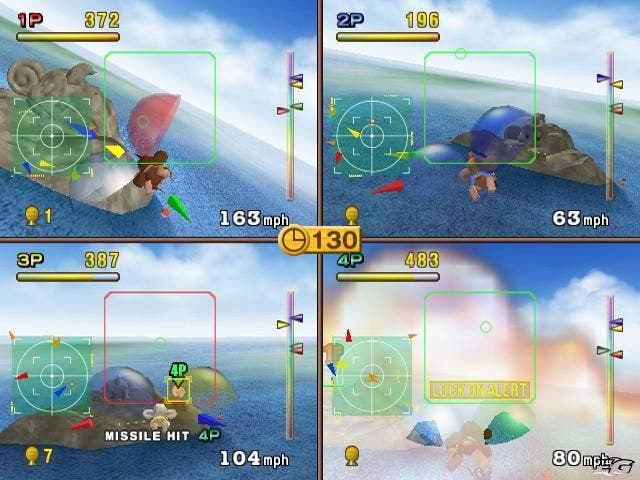
Monkey Force
Of the three others, Monkey Boat, Monkey Shot and Monkey Dogfight, Dogfight is the best. Rather like Lylatwars' multi-player, you skirt around a packed 3D fly-zone trying to line your sights on the enemy, with a little radar, a big fat aiming reticule and a fairly insignificant health bar. Very little in the whole game comes close to the mad panic as four rival fighters from all corners of the screen converge en masse and slip gracefully into one another's sights...
Sadly though, neither Boat nor Shot does much to keep up. Boat reverses the steering (because it's canoeing, apparently), as the left and right triggers cleverly work the paddle, but it's like a My First Wave Race Clone, and doesn't play particularly well. It's not really worth bothering with until the end, but definitely do get it before you spend your final 2500 points on Monkey Shot, a basic and uninspiring shoot 'em up. On a related note, do you remember the end credits game from the first Monkey Ball, of rolling through a sea of bananas and avoiding the names and credits? This time we have a 2D vertical shoot 'em up, and it actually outdoes Monkey Shot (and can be bought for posterity once you've unlocked everything else).
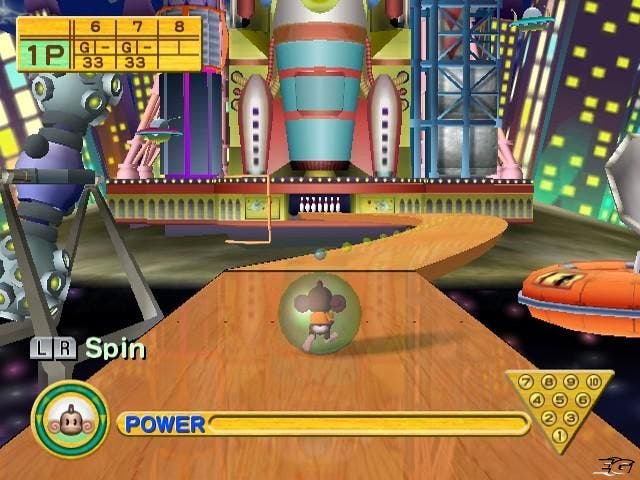
In loving memory of the purple pad…
Ah, you're wondering, but what of our old favourites? What genius has Sega sewn into the lining of Monkey Bowling for example? How does Monkey Golf differ? Alarmingly, Sega hasn't been coy about fiddling with our old haunts, and almost caused pandemonium for meddling with office faves Bowling and Target, so we'll start with them.
Monkey Bowling was one of the best things you could do with the first game - a fairly unquestionable simulation of the sport cut down to its least intimidating. Pick a line, pick an angle, fill the gage and add spin - very simple, and endlessly enjoyable. Here we have the same old game, but each of the monkeys now has attributes. Gongon, for example, throws the fastest ball this side of the Cricket World Cup, but his aiming arrow swings back and forward like Geri Halliwell on Howard Stern's radio show. Conversely, Baby gives you all the time in the world to aim at a relaxed pace, but skips down the lane like an electric pram with an EMP attachment. Aiai and Meemee are closer to their former selves, but the effect of the post-gage, pre-launch spin adjustments are borne out differently, with the ball veering violently at the last rather than curving gradually any more. It doesn't make a huge amount of difference to the gameplay, but it does add something to the tension.
Did we need those changes? Perhaps not, but they're forgivable. And as a bonus (or apology, perhaps), we're also given Special mode, with those wacky, pulsating, rippling, bending lanes you've seen in the screenshots. The idea is to complete three levels' worth by totting up the right amount of points to unlock the next one. A totally unnecessary inclusion which provides endless hours of fun.
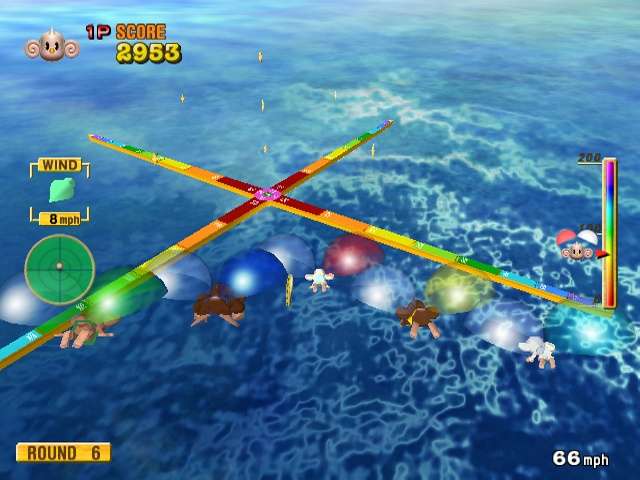
Fly me to Bad-boon…
Monkey Target has also seen a few changes. You can fly in formation, as you've seen (switching with B), landing multiple balls for maximum points, and the sky is now strewn with far more bananas. This isn't so much of a problem, but also new to the sky are various power-ups, and these upset the balance. Magnets, for example, stick your main monkey to the target, allowing you to switch into overhead view with Y and plant a simian wherever you like, eliminating the precision required previously. The brakes power-up, likewise, gives you far too much control on the ground.
But all of that is easily forgotten when you load up the multi-player mode and realise it's in split-screen. There is nothing more entertaining in the whole of Monkey Ball 2 than four players going kamikaze as they all try to mop up a fair share of the points. And landing on 750 only to be shunted into the ocean may not break pads, but it'll break jaws.
Mercifully, Sega hasn't taken too many steps with the other returnees (Kristan's thankful just being given a break from reading this epic). Billiards offers four variations and has a cutesy Wild West bar background complete with milk-sipping Monkey cowboy; Race has bigger arenas and up to eight competitors, with a Grand Prix mode; Fight has new power-ups and a crumbling arena option (recommended); and Golf now has bigger, 18-hole courses with a shot system to rival Mario Golf.
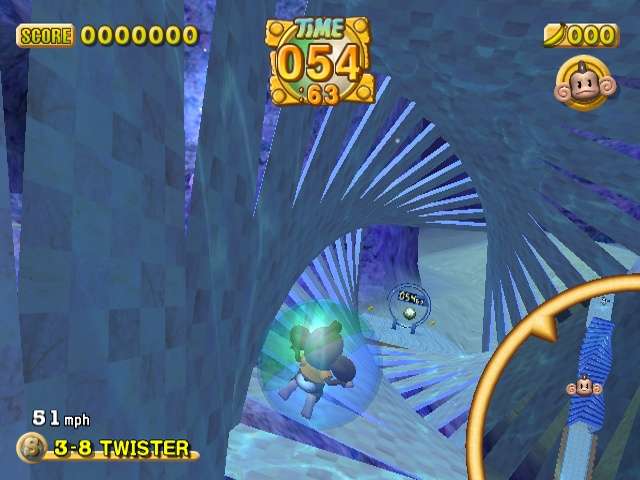
Wherefore art thou monkey?
We'll never know why Sega went for monkeys, really, but if we had to guess then it'd be down to the aesthetic, and Monkey Ball 2 knows how good it looks and makes no attempt to mess with its forerunner's efforts. The graphics engine is identical, although a lot more detail has been lavished on the backgrounds (world four, inside a whale, is just spellbinding to watch - if you're taking it in turns, it'll keep the off-turn player happy for ages), and some of the effects like spitting lava now invade the arena. Still though, the monkeys edge around as per normal with the same animation (albeit with a few situational changes, like goal celebrations for Monkey Soccer), the levels are the same sharp, smoothly constructed shine-a-thons, and the whole thing is precisely crafted to Sega's comic specs.
Sadly though, instead of fixing the eye that views it all, the developer left Monkey Ball's infuriating camera utterly unchanged. As before, the view is from behind and takes hours to catch up, apparently unsure how to interpret your hopeful twiddles. This can be annoying if you're trying to watch for the right moment to run (which happens a lot), because your monkey is always moving at a slow pace, forcing you to roll him around to stop him falling off an edge or something, at the expense of sending the camera haywire. And there's still no clear way to keep the camera in check during flight, which, given the number of levels demanding inch-perfect landings (like the astonishingly nasty 'Launchers'), is a pretty poor effort really.
Joy pad nirvana
It's hard to remain angry with Super Monkey Ball 2 for too long though, because even more so than its predecessor, there's always something to curb your frustration. The party games are like refreshments as you work your way studiously through the Story/Challenge stages, and with 12 of them (and only a couple of duds among 'em) you'll lose many an evening to SMB2. Plus, it's harmless enough to convince the wife, girlfriend, au pair, neighbour, kids, goat or ancestors to have a go. Who can argue with cute, chirping monkeys on a quest to rescue bananas? We didn't say goat.
That said though, it's impossible to recommend SMB2 unconditionally, because it's still very hard to play, despite probably frustrating the hardcore with its new approach - thus failing to win both sets of fans over. But if you can deal with that, the useless camera doesn't sound like a showstopper and motion sickness isn't a problem, then strap on your simian capsules and spout some unintelligible Japlish, because the monkeys are back and your Cube needs this game.

